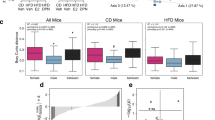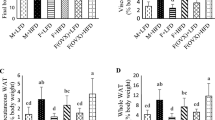Abstract
Sex differences have been found in the incidence and progression of inflammatory bowel diseases (IBD) such as ulcerative colitis and Crohn’s disease. The reported differences in observational studies are controversial, and the effects of sex hormones on the pathogenesis of IBD are not clear. The aim of this study was to analyze sex differences in the progression of experimentally induced colitis. Experimental colitis was induced in adult mice by adding 2 % dextran sodium sulfate (DSS) into drinking water. Male and female mice were used as intact, gonadectomized, and supplemented with either estradiol or testosterone. In comparison to males, female mice with induced colitis had significantly longer colon (p < 0.05), lower decrease in body weight (p < 0.001), and lower stool consistency score (p < 0.05). Histopathological analysis showed less inflammatory infiltrates (p < 0.001) and crypt damage (p < 0.001) in female mice. Female mice with colitis had also lower concentration of TNF-α in colon homogenates (p < 0.01). Supplementation with estradiol in ovariectomized mice ameliorated the severity of colitis. Female mice are partially protected against chemically induced colitis. This protection seems to be mediated by estradiol.







Similar content being viewed by others
References
Cosnes, J., C. Gower-Rousseau, P. Seksik, and A. Cortot. 2011. Epidemiology and natural history of inflammatory bowel diseases. Gastroenterology 140: 1785–1794.
Molodecky, N.A., I.S. Soon, D.M. Rabi, W.A. Ghali, M. Ferris, G. Chernoff, E.I. Benchimol, R. Panaccione, S. Ghosh, H.W. Barkema, and G.G. Kaplan. 2012. Increasing incidence and prevalence of the inflammatory bowel diseases with time, based on systematic review. Gastroenterology 142: 46–54.
Sartor, R.B. 2006. Mechanisms of disease: pathogenesis of Crohn’s disease and ulcerative colitis. Nat Clin Pract Gastroenterol Hepatol 3: 390–407.
Herrinton, L.J., L. Liu, J.D. Lewis, P.M. Griffin, and J. Allison. 2008. Incidence and prevalence of inflammatory bowel disease in a Northern California managed care organization, 1996–2002. Am J Gastroenterol 103: 1998–2006.
Jacobsen, B.A., J. Fallingborg, H.H. Rasmussen, K.R. Nielsen, A.M. Drewes, E. Puho, G.L. Nielsen, and H.T. Sorensen. 2006. Increase in incidence and prevalence of inflammatory bowel disease in northern Denmark: a population-based study, 1978–2002. Eur J Gastroenterol Hepatol 18: 601–606.
Molinie, F., C. Gower-Rousseau, T. Yzet, V. Merle, B. Grandbastien, R. Marti, E. Lerebours, J.L. Dupas, J.F. Colombel, J.L. Salomez, and A. Cortot. 2004. Opposite evolution in incidence of Crohn’s disease and ulcerative colitis in Northern France (1988–1999). Gut 53: 843–848.
Lok, K.H., H.G. Hung, C.H. Ng, K.K. Li, K.F. Li, and M.L. Szeto. 2007. The epidemiology and clinical characteristics of Crohn’s disease in the Hong Kong Chinese population: experiences from a regional hospital. Hong Kong Med J 13: 436–441.
Lopez-Serrano, P., J.L. Perez-Calle, E. Carrera-Alonso, T. Perez-Fernandez, G. Rodriguez-Caravaca, D. Boixeda-de-Miguel, and C.M. Fernandez-Rodriguez. 2009. Epidemiologic study on the current incidence of inflammatory bowel disease in Madrid. Rev Esp Enferm Dig 101: 768–772.
Tsianos, E.V., K.H. Katsanos, D. Christodoulou, I. Dimoliatis, A. Kogevinas, and R.F. Logan. 2003. Northwest Greece inflammatory bowel disease study: continuing low incidence of Crohn’s disease in Northwest Greece. Dig Liver Dis 35: 99–103.
Wagtmans, M.J., H.W. Verspaget, C. Lamers, and R.A. van Hogezand. 2001. Gender-related differences in the clinical course of Crohn’s disease. Am J Gastroenterol 96: 1541–1546.
Blumenstein, I., E. Herrmann, N. Filmann, C. Zosel, W. Tacke, H. Bock, A. Dignass, F. Hartmann, S. Zeuzem, J. Stein, and O. Schroder. 2011. Female patients suffering from inflammatory bowel diseases are treated less frequently with immunosuppressive medication and have a higher disease activity: a subgroup analysis of a large multi-centre, prospective, internet-based study. J Crohns Colitis 5: 203–210.
Zelinkova, Z., E. Bultman, L. Vogelaar, C. Bouziane, E.J. Kuipers, and C.J. van der Woude. 2012. Sex-dimorphic adverse drug reactions to immune suppressive agents in inflammatory bowel disease. World J Gastroenterol 18: 6967–6973.
Allison, J., L.J. Herrinton, L. Liu, J. Yu, and J. Lowder. 2008. Natural history of severe ulcerative colitis in a community-based health plan. Clin Gastroenterol Hepatol 6: 999–1003.
Bernell, O., A. Lapidus, and G. Hellers. 2000. Risk factors for surgery and postoperative recurrence in Crohn’s disease. Ann Surg 231: 38–45.
Hofer, B., T. Bottger, T. Hernandez-Richter, J.K. Seifert, and T. Junginger. 2001. The impact of clinical types of disease manifestation on the risk of early postoperative recurrence in Crohn’s disease. Hepatogastroenterology 48: 152–155.
Jess, T., E.V. Loftus, W.S. Harmsen, A.R. Zinsmeister, W.J. Tremaine, L.J. Melton, P. Munkholm, and W.J. Sandborn. 2006. Survival and cause specific mortality in patients with inflammatory bowel disease: a long term outcome study in Olmsted County, Minnesota, 1940–2004. Gut 55: 1248–1254.
Binder, V. 2004. Epidemiology of IBD during the twentieth century: an integrated view. Best Pract Res Clin Gastroenterol 18: 463–479.
Jess, T., K.V. Winther, P. Munkholm, E. Langholz, and V. Binder. 2002. Mortality and causes of death in Crohn’s disease: follow-up of a population-based cohort in Copenhagen County, Denmark. Gastroenterology 122: 1808–1814.
Godet, P.G., G.R. May, and L.R. Sutherland. 1995. Meta-analysis of the role of oral contraceptive agents in inflammatory bowel disease. Gut 37: 668–673.
Khalili, H., L.M. Higuchi, A.N. Ananthakrishnan, J.M. Richter, D. Feskanich, C.S. Fuchs, and A.T. Chan. 2013. Oral contraceptives, reproductive factors and risk of inflammatory bowel disease. Gut 62: 1153–1159.
Riis, L., I. Vind, P. Politi, F. Wolters, S. Vermeire, E. Tsianos, J. Freitas, I. Mouzas, V.R. Ochoa, C. O’Morain, S. Odes, V. Binder, B. Moum, R. Stockbrugger, E. Langholz, P. Munkholm, and I.B.D. Ec. 2006. Does pregnancy change the disease course? A study in a European cohort of patients with inflammatory bowel disease. Am J Gastroenterol 101: 1539–1545.
Kane, S.V., and D. Reddy. 2008. Hormonal replacement therapy after menopause is protective of disease activity in women with inflammatory bowel disease. Am J Gastroenterol 103: 1193–1196.
Ballinger, A.B..., M.O. Savage, and I.R. Sanderson. 2003. Delayed puberty associated with inflammatory bowel disease. Pediatr Res 53: 205–210.
Mason, A., S.C. Wong, P. McGrogan, and S.F. Ahmed. 2011. Effect of testosterone therapy for delayed growth and puberty in boys with inflammatory bowel disease. Horm Res Paediatr 75: 8–13.
Azooz, O.G., M.J. Farthing, M.O. Savage, and A.B... Ballinger. 2001. Delayed puberty and response to testosterone in a rat model of colitis. Am J Physiol Regul Integr Comp Physiol 281: 1483–1491.
Deboer, M.D., and Y.L. Li. 2011. Puberty is delayed in male mice with dextran sodium sulfate colitis out of proportion to changes in food intake, body weight, and serum levels of leptin. Pediatr Res 69: 34–39.
Resta-Lenert, S., J. Smitham, and K.E. Barrett. 2005. Epithelial dysfunction associated with the development of colitis in conventionally housed mdr1a−/− mice. Am J Physiol Gastrointest Liver Physiol 289: 153–162.
Mahler, M., I.J. Bristol, E.H. Leiter, A.E. Workman, E.H. Birkenmeier, C.O. Elson, and J.P. Sundberg. 1998. Differential susceptibility of inbred mouse strains to dextran sulfate sodium-induced colitis. Am J Physiol 274: 544–551.
Verdu, E.F., Y. Deng, P. Bercik, and S.M. Collins. 2002. Modulatory effects of estrogen in two murine models of experimental colitis. Am J Physiol Gastrointest Liver Physiol 283: 27–36.
Harnish, D.C., L.M. Albert, Y. Leathurby, A.M. Eckert, A. Ciarletta, M. Kasaian, and J.C. Keith Jr. 2004. Beneficial effects of estrogen treatment in the HLA-B27 transgenic rat model of inflammatory bowel disease. Am J Physiol Gastrointest Liver Physiol 286: 118–125.
Gunal, O., B.K. Oktar, E. Ozcinar, M. Sungur, S. Arbak, and B. Yegen. 2003. Estradiol treatment ameliorates acetic acid-induced gastric and colonic injuries in rats. Inflammation 27: 351–359.
Heijmans, J., M.C. Wielenga, S.L. Rosekrans, J. Roelofs, P. Groothuis, A. Ederveen, E.S. de Jonge-Muller, I. Biemond, J.C. Hardwick, G. D’Haens, D.W. Hommes, V. Muncan, G.R. van den Brink, and J.F. van Lidth de Jeude. 2014. Oestrogens promote tumorigenesis in a mouse model for colitis-associated cancer. Gut 63: 310–316.
Cook, L.C., A.E. Hillhouse, M.H. Myles, D.B. Lubahn, E.C. Bryda, J.W. Davis, and C.L. Franklin. 2014. The role of estrogen signaling in a mouse model of inflammatory bowel disease: a Helicobacter hepaticus model. PLoS ONE 9: e94209.
Harris, H.A., L.M. Albert, Y. Leathurby, M.S. Malamas, R.E. Mewshaw, C.P. Miller, Y.P. Kharode, J. Marzolf, B.S. Komm, R.C. Winneker, D.E. Frail, R.A. Henderson, Y. Zhu, and J.C. Keith Jr. 2003. Evaluation of an estrogen receptor-beta agonist in animal models of human disease. Endocrinology 144: 4241–4249.
Palffy, R., R. Gardlik, M. Behuliak, P. Jani, D. Balakova, L. Kadasi, J. Turna, and P. Celec. 2011. Salmonella-mediated gene therapy in experimental colitis in mice. Exp Biol Med (Maywood) 236: 177–183.
Dieleman LA, Palmen M, Akol H, Bloemena E, Pena AS, Meuwissen SGM, and van Rees EP Chronic experimental colitis induced by dextran sulphate sodium (DSS) is characterized by Th1 and Th2 cytokines. Clin Exp Immunol 114: 385–391
Kim, J.J., M.S. Shajib, M.M. Manocha, and W.I. Khan. 2012. Investigating intestinal inflammation in DSS-induced model of IBD. J Vis Exp 60: e3678.
Ambrosini, R., A. Barchiesi, V. Di Mizio, M. Di Terlizzi, L. Leo, A. Filippone, L. Canalis, R. Fossaceca, and A. Carriero. 2007. Inflammatory chronic disease of the colon: how to image. Eur J Radiol 61: 442–448.
Saleiro D, Murillo G, Benya RV, Bissonnette M, Hart J and Mehta RG Estrogen receptor-ss protects against colitis-associated neoplasia in mice. Int J Cancer 131: 2553–2561
Geerling, B.J., W.D.V. Lichtenbelt, R.W. Stockbrugger, and R.J.M. Brummer. 1999. Gender specific alterations of body composition in patients with inflammatory bowel disease compared with controls. Eur J Clin Nutr 53: 479–485.
Jahnsen, J., J.A. Falch, P. Mowinckel, and E. Aadland. 2003. Body composition in patients with inflammatory bowel disease: a population-based study. Am J Gastroenterol 98: 1556–1562.
Oh, J.E., Y.W. Kim, S.Y. Park, and J.Y. Kim. 2013. Estrogen rather than progesterone cause constipation in both female and male mice. Korean J Physiol Pharmacol 17: 423–426.
Looijer-van Langen, M., N. Hotte, L.A. Dieleman, E. Albert, C. Mulder, and K.L. Madsen. 2011. Estrogen receptor-beta signaling modulates epithelial barrier function. Am J Physiol Gastrointest Liver Physiol 300: 621–626.
O’Mahony, F., W. Thomas, and B.J. Harvey. 2009. Novel female sex-dependent actions of oestrogen in the intestine. J Physiol 587: 5039–5044.
Acknowledgments
This study was funded by the Slovak Ministry of Education, Science, Research and Sport—grant number VEGA 1/0406/13 and by Comenius University Grant UK/315/2015.
Conflict of Interest
The authors confirm that there are no conflicts of interest to declare.
Author information
Authors and Affiliations
Corresponding author
Rights and permissions
About this article
Cite this article
Bábíčková, J., Tóthová, Ľ., Lengyelová, E. et al. Sex Differences in Experimentally Induced Colitis in Mice: a Role for Estrogens. Inflammation 38, 1996–2006 (2015). https://doi.org/10.1007/s10753-015-0180-7
Published:
Issue Date:
DOI: https://doi.org/10.1007/s10753-015-0180-7




